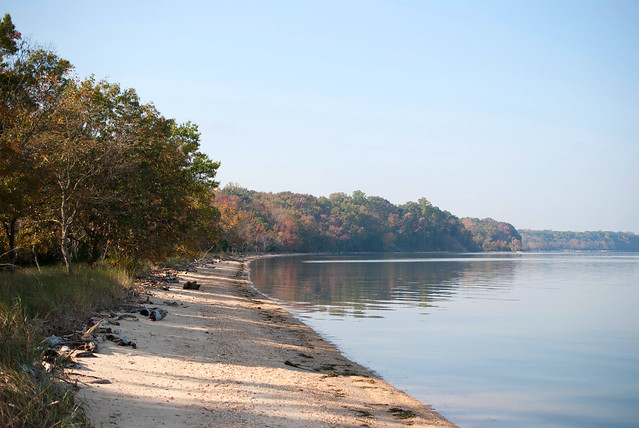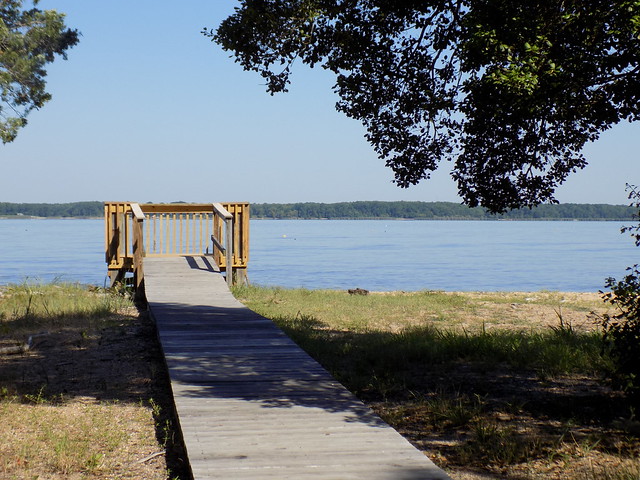Read Our Blogs
A Spy Camp Named Eagle's Nest
Caledon State Park is home to some truly fascinating history that many are not aware of. As what looks to be a quiet, unsuspecting beach, Boyd’s Hole was actually very active at one point in time.
Back in the Colonial Period, Boyd’s Hole was a lively shipping port, ferry landing, and tobacco inspection station. A few families ran the businesses down there, and there were even a few homes surrounded by farmland on one side and the Potomac River as a backdrop on the other.
Looking up river at Boyd's Hole at Caledon State Park
Over the years, the liveliness of this post settled down, but it found new life with the advent of the Civil War. Its location right on the Potomac River (Union-Confederate Boundary line) proved useful to at least two different spies during the war. Thomas Nelson Conrad is the best known of the two. He started out as a Methodist preacher and teacher at a private school in Washington D.C. and later founded his own boys’ school called the Georgetown Institute. Arrested several times for his blatant support of the Confederacy and sneaking around for Union information, he was sent to Virginia as part of a prisoner exchange. Once in the Confederate States, Conrad became a chaplain and a scout for the 3rd Virginia Calvary.
Upon “JEB” Stuart’s nomination and President Jefferson Davis’s approval, Thomas Conrad Nelson was promoted to a spy within the Confederate Secret Service. As a spy, he set up camp right here on a high cliff near Boyd’s Hole. He named this camp Eagle’s Nest on account of the bald eagle which nested in the tree just above his shanty. In his book, A Confederate Spy, Conrad described that eagle as a confederate sympathizer saying, “The moment an enemy was in sight, she would leave her nest, rise fifty feet or so above the tree-tops and circling round and round emit a series of shrieks, which did not cease until everything had quieted down.” Conrad and his team occupied this post for more than two years. He wrote, "The naval office of the 'Potomac Flotilla' had a general idea as to my movements and the location of our camp and occasionally, as a pastime, shelled the woods, which hid the shanty from view. Frequently those shells were not only unwelcome but extremely uncomfortable visitors." The Caledon State Park Visitor Center displays a Union cannon shell that was found right around Boyd's Hole over thirty years ago.
Cannon shell found at Boyd's Hole
This job as a spy took him back to D.C. several times to meet with foreign sympathizers, smuggle people across the Potomac, and find out Union secrets. To limit the number of trips he would have to make himself, Thomas Nelson Conrad developed an extensive line of communication called the “doctor’s line.” Since doctors wouldn’t be suspected of doing anything illegal by traveling great distances in the dead of night, he enlisted country doctors who could pass along information to one another and eventually across the river to Eagle’s Nest. This “doctor’s line” could transmit information from D.C. to Richmond in less than twenty-four hours. Conrad painted himself as a master of disguise in his memoirs published some thirty years later, describing the various outfits he would wear so as to remain unsuspected. At different times, he would don a beard, dress as a Union Chaplain, or wear a businessman's clothes to complete his missions.
Scenic Boyd's Hole
Conrad’s life was very colorful, though much of what we know about him comes from his own works, in which he speaks very highly of himself. Throughout the war, Conrad was known for passing along information that led to the Confederate victory in the Battle of Fredericksburg, he had his own conspiracy to kidnap Abraham Lincoln, and he was even arrested for suspicions of his involvement in the President’s assassination. He escaped this by jumping off of a train and proceeded to flee west to the Shenandoah Valley, where he hid for a few months. He eventually returned to his roots in education and became the third president of the Virginia Agricultural and Mechanical College (later named Virginia Tech).
Caledon State Park is home to an Old Growth Forest, many hiking trails, miles of Potomac River shoreline, and a population of year-round bald eagles.
We are located in King George County on the Northern Neck of Virginia.
Drive Time: Northern Virginia, 1 hour 45 minutes; Richmond, 1 hour, 30 minutes; Tidewater/Norfolk/Virginia Beach, 3 hours, 30 minutes; Roanoke, 3 hours, 30 minutes. For directions to Caledon State Park, click here.
If you have read the article and have a question, please email nancy.heltman@dcr.virginia.gov.
Search for blogs
By Park
Categories
Cabins
Camping
Fishing
History and Culture
Other
Programs and Events
Trails
Volunteers
Water Fun
Archive
2024
2023
2022
2021
2020
2019
2018
2017
2016
2015
2014
2012

















